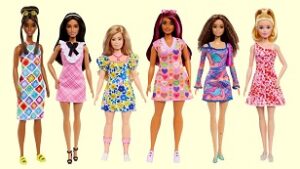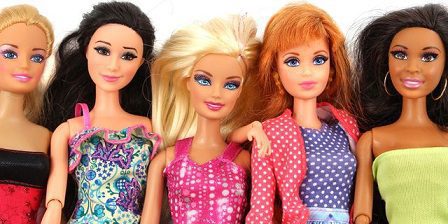Enigmatic Story of Barbie: In Barbieland, the beloved fashion doll has always loved shoes. In fact, Greta Gerwig’s “Barbie” movie revolves around her feet. Margot Robbie’s Barbie character’s graceful tip-toe pose captivated audiences worldwide. After the trailer’s release, Google Trend searches for fluffy mules increased by 115%.
Barbie has always been associated with the stiletto mule, also known as a stiletto slide or sandal. Barbie has had many shoe options in her 64-year wardrobe. The stiletto mule is her signature style.
Barbie’s feet are crucial to the movie. Her arches falling portends trouble. She consults Kate McKinnon’s Weird Barbie to decide between pink pumps and brown Birkenstocks, reminiscent of “The Matrix”‘s red pill-blue pill choice.
Margot Robbie wowed audiences with her Barbie-themed outfits on the “Barbie” press tour. Manolo Blahnik’s custom high-heeled mules complemented many of her outfits. For a Seoul press conference, Robbie recreated the 1964 “Sparkling Pink” Barbie.
Mules add charm. “When you walk in mules,” said Manolo Blahnik. Madame de Pompadour on mules, clicking around Versailles. Anything more exquisite?”
Mattel co-founder Ruth Handler introduced Barbie in 1959 with the stiletto mule. The German comic strip Bild Lilli, an audacious high-end call girl who became an adult novelty doll, inspired the doll. Barbie wore Charlotte Johnson backless heels and a black and white striped bathing suit.
With its revealing slide-like structure and thin high heel, the stiletto mule instantly became a symbol of feminine desirability. Barbie’s cultural impact increased as stiletto heels became popular.
Kim Culmone, Senior Vice President of Barbie Design at Mattel, said collector dolls and reproductions still wear open-toe backless shoes, including mules. For playable dolls, other shoe styles are often chosen to ensure durability.
The mule’s history is linked to cultural changes beyond Barbie’s. Mules have symbolized playfulness, privacy, and intimacy for centuries. Upper-class women began wearing ornate backless slippers in the 1600s. As social gatherings became more intimate in the 18th century, the mule became fashionable for wider occasions. Marie Antoinette’s silk mules were prized.
Mid-19th-century women’s fashion revived the heeled mule, evoking 18th-century style. It remained linked to domestic life and undress. Women wearing only mules in 19th-century erotic photography hypersexualized high heels. In the 1930s, the peep toe style added to the mule’s appeal, and in the 1950s, Frederick’s of Hollywood popularized it as a seductive boudoir slipper.
The stiletto heel’s origins are unclear, but the 1950s saw a sharp, sleek look. André Perugia’s 1951 “needle heel” sandal used metal to support women’s weight. Marilyn Monroe, Barbara Eden, and Jayne Mansfield, who wore stiletto mules, cemented the Hollywood glamour connection.
In popular culture, the stiletto mule is garish and glamorous, making a statement. In “Female Trouble,” Divine’s character Dawn Davenport rebelled against her parents for not buying the heels. Anton LaVey, the Church of Satan’s controversial founder, linked the shoe’s daring and cheap reputation to witches with thick skin.


READ MORE: The Entertainment Industry: Hollywood Struggle Strikes and Box Office Flops Rock
Katey Sagal’s Peggy Bundy in “Married With Children” popularized stiletto mules. Debbie Harry of Blondie and Olivia Newton-John performed with mules, cementing their popularity. Dolly Parton and Angelyne still wear stiletto mules.
Polly of California helped revive the stiletto mule in the early 2000s. Betsey Johnson wore ankle-strapped Polly mules in her Spring-Summer 2001 show. Polly mules, the eight-hour heels, had foam-padded insoles and a platform wooden base for all-day comfort.
Polly of California no longer exists, but Los Angeles vintage shoe brand Re-Mix has adopted Polly’s Hollywood Stilettos Slide. They continue this elegant, nostalgic style.
The stiletto mule is poised for a comeback in Barbiecore, a mainstream trend. In collaboration with the “Barbie” movie, Aldo released a kitten-heeled mule. Stiletto mules remain popular with celebrities like Jennifer Lawrence and Rihanna. Malone Souliers co-creative directors Coco Fong and Valerio Bava have noticed an increased interest in the heeled mule, recognizing its glamour and nostalgia.
The stiletto mule needs to break free, like Barbie in the “Barbie” movie.
Our Reader’s Queries
What is the true story behind Barbie?
Ruth Handler drew inspiration for the Barbie doll from her daughter Barbara, who sparked the idea while playing with paper dolls. Handler wanted to go beyond the typical plastic baby dolls and create something that would empower children to dream about their future. Her goal was to encourage imagination and ambition in young minds, leading to the birth of the iconic Barbie doll.
What is the deeper meaning of the Barbie movie?
Barbie confronts her insecurities and ultimately becomes the savior of Barbieland. The film delivers a strong commentary on the patriarchy and the empowerment of women. In Barbieland, the classic Barbie character is oblivious to the impact of her stereotypical image on the world and the feminist movement.
What is the story about Barbies?
Barbie made her grand entrance on March 9, 1959, at the American International Toy Fair in New York City, brought to life by Ruth Handler of Mattel, Inc. Ruth was inspired by the German Lilli doll in 1956, sparking the start of Barbie’s creation. The Barbie doll was then released for sale in 1958.
What is the story behind Barbie movie?
Margot Robbie, an executive producer as well, takes on the role of Stereotypical Barbie in the musical comedy. Barbie goes through an existential crisis and sets off on a quest to discover herself. Ryan Gosling joins her as Ken, her boyfriend.

